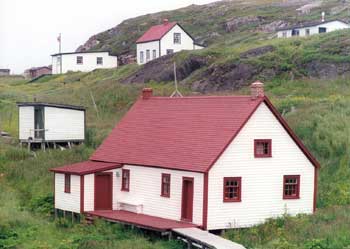The development of Newfoundland and Labrador society has been influenced predominately by Aboriginal and European cultures, and the environment. Cultural heritage assets are generally linked to historic and archaeological sites, museums, archives and other unique places and buildings that have played an important role in the development of the Provinceís cultural distinction. Heritage activities are generating more employment and income than ever before as society continues to recognize and value its history and cultural heritage symbols. For example, a renewed interest in genealogical research draws many individuals from other parts of Canada and the U.S. to this province to trace their roots back to the immigration of Europeans over 400 years ago.
Heritage attractions are becoming an increasing part of the Provinceís tourism product and an important contributor to regional economies. The Museum Association of Newfoundland and Labrador reported that in 1999 over 100 community museums received more than 200,000 visitors.
Special promotions, geared to highlight key historical events, have proven to be highly successful in increasing tourism visitation. This year, for example, the Province will celebrate the 100th anniversary of Guglielmo Marconiís receipt of the first Trans Atlantic wireless signal at Signal Hill.
|
| |
 |
|
|
In response to increasing demand, the number of local heritage attractions and activities (which register one million visits annually) is growing through the development of interpretative exhibits, living interpretation, and restored heritage buildings. Archaeology sites and active digs provide visitors with additional opportunities to witness history being uncovered and are increasingly popular. Profiled below are two successful examples of this growing segment of the economy.
Colony of Avalon
Located along the south eastern portion of the Avalon Peninsula, the Colony of Avalon features an active archeological dig of an early 17th century colony. This site is one of the best preserved colonial sites of early British North America with over one million artifacts uncovered to date. Site visitation has increased by an average of 25% per year, reaching almost 17,000 in 2000. The Colony plays a key role in the regionís tourism infrastructure and is a significant tourism attraction.
Battle Harbour
Battle Harbour, Labrador, which dates to the 1770s has been restored and is an excellent example of a past way of life that revolved around the early fishery. This site was once the economic and social centre of the Labrador coast. Today, it has been designated as one of 15 National Historic Districts in the Country. Many historic structures, walkways and work areas have been restored and a collection of more than 300 artifacts is on display.
Efforts are now being focussed on marketing the site. In recent years, an average of close to 2,000 visitors have come to Battle Harbour. Visitation is expected to grow in the near future with the extension of the Trans Labrador Highway to Maryís Harbour (see map
in 2001 Expectations). Last year, three cruiseship port of calls were made at Battle Harbour; in 2001, this figure is expected to increase to eight.
|
| |
| |
Photo: Gordon C. Slade
Cookhouse/Bunkhouse, Battle Harbour |
|

